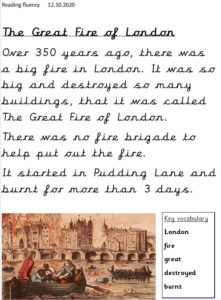Here is your home learning for this week with a welcome video from Mrs Latham.
Maths
This week’s maths learning is linked counting and place value.
Year 1
- Lesson 1 video, worksheet and answers.
- Lesson 2 video, worksheet and answers.
- Lesson 3 video, worksheet and answers.
- Lesson 4 video, worksheet and answers.
- Lesson 5 counting to 100, counting in 2s and 10s. (These are YouTube links. Top tip for watching YouTube with your child: go to the settings cog along the play bar and turn off autoplay – this avoids an inappropriate clip coming up automatically, and helps to discourage your child from passively watching clip after clip.)
You don’t have to print the worksheets. Your child can write or draw their answers on paper. Your child’s learning will be most effective if you sit with them to pause the clip and check / praise / support your child as the clip moves on.
(Suggested time: 30 minutes of Maths and 15 minutes of Rockstars daily)
Spelling
Look on the homework page to find this week’s spellings. Your child should complete one task each day.
- Day 1: Write the words and draw shapes round them to show the ascenders and descenders. (Set yourself and others at home a challenge of using some of the words when you’re speaking, too!)
- Day 2: Write the words using rainbow writing. (Try some of the other activities in our super spelling strategies)
- Day 3: Write separate sentences, each containing one of the spellings. Don’t forget to show off really neat handwriting and make sure you sentence starts with a capital letter and ends with a full stop, exclamation mark (!) or question mark (?).
- Day 4: Repeat Task 2 or 3.
- Day 5: Get an adult at home to test you on your spellings. Practise any you spell incorrectly – you could write them out carefully until you’re sure.
(Suggested time: 15-20 minutes daily)
Reading fluency
This is the text we’re using in class this week to build up fluency skills.

In school, we generally follow this sequence:
- Day 1: Read the text aloud with your child listening. Read it clearly and slowly, pointing to each word as you read. Have a chat about any unfamiliar words.
- Day 2: Read aloud each sentence (a full short sentence or part of a longer sentence), and have your child read it back to you. Do this ‘echo reading’ for the whole text.
- Day 3: Read the text and talk about the effect of the punctuation on how you read it – pauses for full stops and expression for exclamations (!) or questions (?). Your child reads the text aloud.
- Day 4: Read together with expression (just like you practised on Day 3).
- Day 5: Your child reads independently and fluently.
(Suggested time: 15 minutes daily)
Reading comprehension and phonics
Day 1: We’ll be using this ‘RIC’ text in class to practise comprehension skills. RIC stands for:
- Retrieve: finding information in a text
- Interpret: using clues in the text or pictures to unlock information
- Choice: thinking about the author’s choice of words, techniques or organisation that make the text interesting and enjoyable to read
Day 2: Agree with your child three words from any text they’ve read which they’re less familiar with. Your child should find out what they mean (eg by checking an online dictionary or simply discuss with you) and how to use them in sentences (both when speaking and when writing). Challenge your child to write a sentence with each word in, or to drop the words into conversations at home.
Day 3: These video lessons for from BBC Bitesize links to the phonics sounds for ‘or’, ‘ur’ and ‘ow’. Watch the video and complete the activities.
Day 4: Go on a sound hunt around your house and find as many things as you can that contain the phonics sounds ‘or’, ‘ur’ and ‘ow’. Write a list of all the things you find. Challenge : Write sentences containing some of the words.
Day 5: Book Club. Once a week, we have a relaxing lesson where we sit and read quietly, often with an adult. You can read the books you take home from school or some of your own books.
(Suggested time: 30 minutes daily)
Writing
Activity 1:
Year 1 children: Talk to your child about a picture or photograph you choose. Write three words or phrases to label different things in the picture (eg ‘a car’ or ‘a red car’). Your child should aim to spell in a sensible way and use finger spaces between the words, joining up letters if they can (use our handwriting guide to help).
Activity 2:
Finger strengthening activities support the development of fine motor skills needed for writing.
Challenge your child to have a go at 3 or more of these activities: practise tying shoe laces, fasten and unfasten buttons, attach nuts and bolts, separate dried pasta and dried peas (or similar) into two separate piles, do some mindfulness colouring in, do a jigsaw, cut up drinking straws and thread them on to a shoe lace, attach clothes pegs (the squeezable type) to a shoe box or similar, use a paint brush and water to make pictures or words on a wall, chalk words or pictures on the ground, make a Lego model.
(Suggested time: 30 minutes daily)
Topic
This week’s topic learning is History. We are starting to learn about the Great Fire of London. We are reading this book :

You could search for a video of it on You Tube.
(Suggested time: 30 minutes)
Science
We’re learning about food chains, predators and prey. This video will really help to support learning at home. Have a go at drawing a food chain, labelling who is the predator/prey.
(Suggested time: 30-45 minutes)